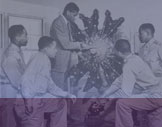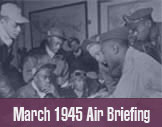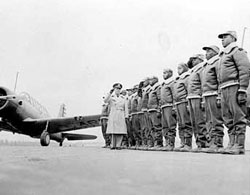





• Those who possessed the physical and mental qualifications and were accepted for aviation cadet training were trained initially to be pilots, and later to be either pilots, navigators, or bombardiers.
• Moton Field is named for Tuskegee University's second President, Dr. Robert R. Moton who served with distinction from 1915-1935. The Airmen were delpoyed during the presidential administration of Dr. Frederick Douglas Patterson (1935-1953).
• The all-Black, 332nd Fighter Group consisted originally of four fighter squadrons, the 99th, the 100th, the 301st and the 302nd.
• From 1940-1946, some 1,000 Black pilots were trained at Tuskegee.
• The Airmen’s success during World War II – not losing a single bomber to enemy fire in more than 200 combat missions – is a record unmatched by any other fighter group.
• The 99th Squadron distinguished itself by being awarded two Presidential Unit Citations (June-July 1943 and May 1944) for outstanding tactical air support and aerial combat in the 12th Air Force in Italy, before joining the 332nd Fighter Group.
• The 332nd Fighter Group was awarded the Presidential Unit Citation for its longest bomber escort mission to Berlin, Germany, March 24, 1945. It destroyed three German ME-262 Jet fighters and damaged five additional jet fighters without losing any of the bombers or any of its own fighter aircraft to enemy fighters.
• The 332nd Fighter Group had also distinguished itself in June 1944 when two of its pilots flying P-47 Thunderbolts discovered a German destroyer in the harbor of Trieste, Italy.
• The tenacious bomber escort cover provided by the 332nd "Red Tail" fighters often discouraged enemy fighter pilots from attacking bombers escorted by the 332nd Fighter Group.
• C. Alfred "Chief" Anderson earned his pilot's license in 1929 and became the first BlackAmerican to receive a commercial pilot's certificate in 1932, and, subsequently, to make a transcontinental flight.
• Anderson is also well known as the pilot who flew Eleanor Roosevelt, wife of then-U.S. President Franklin D. Roosevelt, convincing her to encourage her husband to authorize military flight training at Tuskegee.
• In 1948, President Harry Truman enacted Executive Order No. 9981 - directing equality of treatment and opportunity in all of the United States Armed Forces, which in time led to the end of racial segregation in the U.S. military forces.
• The U.S. Congress authorized $29 million in 1998 to develop the Tuskegee Airmen Naitonal Historic Site, with the University, Tuskegee Airmen Inc. and the National Park Service serving as partners in its development. To date, a mere $3.6 million has been appropriated for the Site’s implementation.
Facts provided by Tuskegee Airmen Inc. and the Tuskegee University Office of Marketing and Communications.
